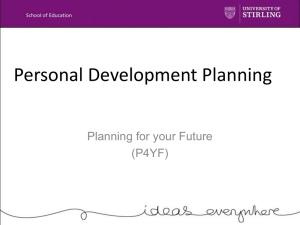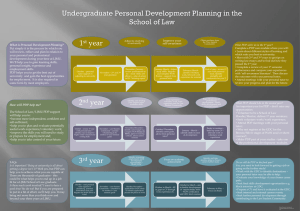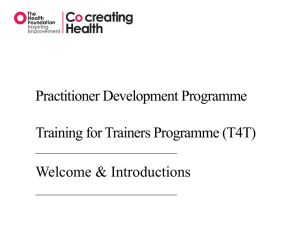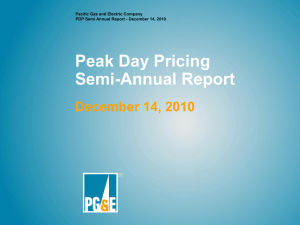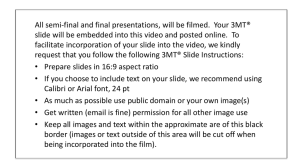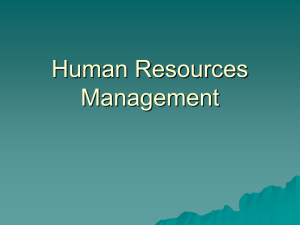Performance Development Plan (PDP)
advertisement
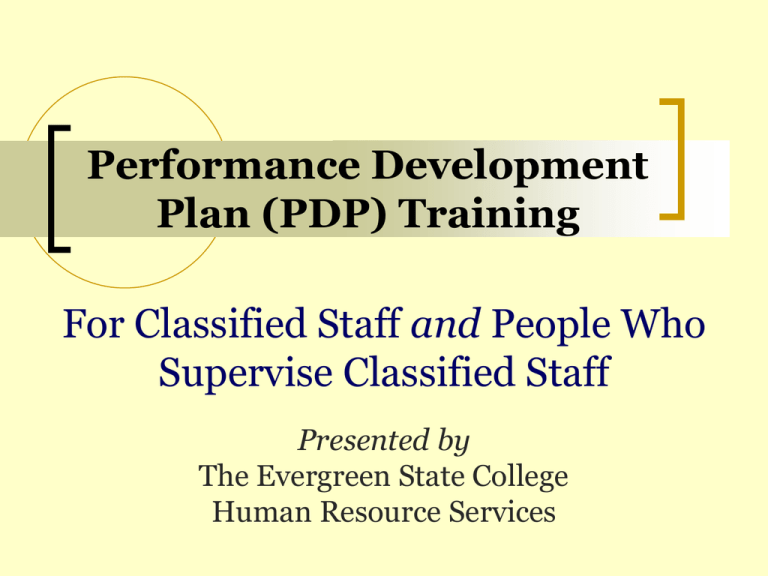
Performance Development Plan (PDP) Training For Classified Staff and People Who Supervise Classified Staff Presented by The Evergreen State College Human Resource Services What to Expect from this Training Supervisors will learn how to… Complete the PDP forms. Set work expectations. Encourage employee participation. Assess work performance. Employees will learn how to… Participate in the PDP process. Get the most out of performance evaluations. Collective Bargaining Agreement – Performance Evaluations Article 6.2 Evaluation Process Employee work performance will be evaluated during probationary, trial service and transition review periods and at least annually thereafter. The immediate supervisor will meet with an employee at the start of his or her review period to discuss performance expectations. The employee will receive copies of his or her performance expectations as well as notification of any modifications made during the review period. The employee will have the opportunity to provide feedback on the evaluation. The PDP Forms The PDP is two separate forms Form 1: Planning Phase To be complete at the beginning of the evaluation period. Beginning = Upon hire, transfer, demotion, and annually thereafter. Form 2: Assessment Phase To be completed at the end of the evaluation period. The end of the review period varies depending on the type of review period. Types of Review Periods Probation (new hires) 6 months but can be extended for up to 12 months. 12 months for Campus Police Officers. Trial Service (promotions, voluntary transfers, or voluntary demotions) 6 months but can be extended for up to 12 months. May be longer for in-training positions. 12 months for Campus Police Officers. Transition Review (employee accepts a layoff option or appointment from layoff list) 6 months but can be extended for up to 12 months. May be shortened. Annual Review (All employees not in a probation, trial, or transition review period) Extending Review Periods A probation, trial, or transition review period allows time for the supervisor to communicate expectations and evaluate technical and behavioral job performance. A review period may be extended for up to 12 months if the technical and/or behavioral expectations are not being met by the employee. Supervisors should consult with Human Resource Services prior to extending a review period. Why do PDPs? Communicate expectations. Measure / enhance performance. Foster professional development / career growth. Set development goals. Recognize exceptional performance. Document areas where improvement is needed. Identify if steps have been taken during the review period to improve performance. What PDPs are not for Performance evaluations will not be used to initiate personnel actions such as transfers or demotions or to impose discipline. Form 1: Planning Phase Performance Expectations & Goals Planning Form 1: Planning Phase Process Overview The supervisor may encourage the employee to draft a Planning Phase PDP of their own. The supervisor and the employee meet to share their draft Planning Phase PDPs. The The supervisor completes a final Planning Phase PDP. supervisor and the employee have a Performance Evaluation meeting where the supervisor shares the final Planning Phase PDP with the employee. Filling out the Planning Phase PDP Heading information Fill in the fields at the top of the form Position Linkage With Organizational Mission and Goals This may not change much from year to year. Filling out the Planning Phase PDP Section 1: Performance Expectations and Goals Planning Part 1: Performance Expectations A. Key Results Expected What are the most important job objectives, outcomes, and/or assignments for the employee to accomplish in order to be successful during the evaluation period? The expected results should be stated in measurable or observable terms, to the degree possible. Filling out the Planning Phase PDP Section 1: Performance Expectations and Goals Planning Part 1: Performance Expectations A. Key Results Expected Examples of Results Expected: 1. Sarah will prepare a comprehensive PDP presentation and provide training during the spring. 2. Sarah will continue to provide HR support to people involved in staff recruitments. 3. Sarah will arrive to work at the scheduled time each workday. Filling out the Planning Phase PDP Section 1: Performance Expectations and Goals Planning Part 1: Performance Expectations B. Key Skills and Abilities Expected What are the most important skills and abilities the employee must demonstrate to perform their position duties successfully? Filling out the Planning Phase PDP Section 1: Performance Expectations and Goals Planning Part 1: Performance Expectations B. Key Skills and Abilities Expected Examples of Skills and Abilities Expected: 1. Sarah must demonstrate skill and ability in using Microsoft PowerPoint to present information in an easy to understand manner. 2. Sarah must be skilled in providing guidance on the Classified and Exempt recruitment processes. 3. Sarah will demonstrate good attendance. Filling out the Planning Phase PDP Section 1: Performance Expectations and Goals Planning Part 2: Training and Development Goals/Opportunities What training and development needs, goals, and opportunities should the employee focus on during this performance period? Filling out the Planning Phase PDP Training and Development Employee Think about what training and/or development would help you perform your job duties. Supervisor Have a conversation with the employee about what training and/or development would be beneficial and possible. Goal setting should be a collaborative process between employee and supervisor. Encourage employees to identifying and prioritize appropriate goals. Keep goals job related. Filling out the Planning Phase PDP Section 1: Performance Expectations and Goals Planning Part 2: Training and Development Goals/Opportunities Examples of Training and Development Goals/Opportunities: 1. Sarah should attend Microsoft PowerPoint training. 2. Sarah’s goal is to improve her public speaking skills by getting feedback from training participants. Filling out the Planning Phase PDP Section 1: Performance Expectations and Goals Planning Part 3: Organizational Support This is for the employee to fill out and is optional. What suggestions do you have as to how your supervisor, co-workers, and/or management can better support you in your present job and future career goals? Filling out the Planning Phase PDP Section 1: Performance Expectations and Goals Planning Part 3: Organizational Support Examples of Organizational Support: 1. I would like to cross train with my coworkers so that we can back each other up when needed. 2. I would like to have bi-weekly meetings with my supervisor to talk about the status of my assignments. Filling out the Planning Phase PDP Section 2: Acknowledgment and Filing Part 1: Acknowledgment of Performance Plan The supervisor and employee sign Section 2, Part 1 to record that they have discussed the Planning Phase PDP at the beginning of the performance period. Filling out the Planning Phase PDP Section 2: Acknowledgment and Filing Part 2: Filing The supervisor retains one copy of the Planning Phase PDP form and provides a copy to the employee. The signed original Planning Phase PDP form is placed in the employee’s personnel file in Human Resource Services. Form 1: Planning Phase PDP Questions about the Planning Phase PDP form or process? Form 2: Assessment Phase Performance Assessment Form 2: Assessment Phase Process Overview Conduct Interim Reviews as needed. The supervisor may encourage the employee to draft an Assessment Phase PDP of their own. The supervisor and the employee meet to share their draft Assessment Phase PDPs. The The supervisor completes a final Assessment Phase PDP. supervisor and the employee have a Performance Evaluation meeting where the supervisor shares the final Assessment Phase PDP with the employee. Filling out the Assessment Phase PDP Section 1: Performance Assessment Part 1: Interim Reviews (Optional) As an option, the Interim Reviews part can be used to document performance feedback and/or update expectations during the performance period. Any modifications made during the review period will be shared with the employee. Filling out the Assessment Phase PDP Section 1: Performance Assessment Part 1: Interim Reviews (Optional) Example of an Interim Review: Sarah and I met in December to discuss her routine tardiness. We discussed ways she could improve by planning her morning routine the night before and setting her alarm clock for an earlier time. Filling out the Assessment Phase PDP Section 1: Performance Assessment Part 2: Performance Feedback In general, Part 2 should provide a narrative assessment of the employee’s performance in relation to the content in Section 1, Parts 1 and 2 of the Planning Phase PDP. The assessment must be based on observed or verified performance. Filling out the Assessment Phase PDP Section 1: Performance Assessment Part 2: Performance Feedback A. Key Results Assessment To what degree did the employee accomplish the expected results and how well were they done? Filling out the Assessment Phase PDP Section 1: Performance Assessment Part 2: Performance Feedback A. Key Results Assessment Examples of Performance Results: 1. Sarah successfully prepared a PDP PowerPoint and gave a well attended training that got great feedback. 2. Sarah provided excellent support to several recruitments which resulted in successful hires. 3. Sarah consistently arrived to work 10-15 minutes late. Filling out the Assessment Phase PDP Section 1: Performance Assessment Part 2: Performance Feedback B. Key Skills and Abilities Assessment How well (or how frequently) did the employee demonstrate the skills and abilities expected? Filling out the Assessment Phase PDP Section 1: Performance Assessment Part 2: Performance Feedback B. Key Skills and Abilities Assessment Examples of Key Skills and Abilities: 1. Sarah demonstrated good information delivery skills when using PowerPoint to develop a PDP training presentation. 2. Sarah continued to demonstrate remarkable communication skills when conducting recruitments. 3. Sarah failed to demonstrate good attendance. Filling out the Assessment Phase PDP Section 1: Performance Assessment Part 2: Performance Feedback C. Training and Development What training was completed? What development goals were achieved? Filling out the Assessment Phase PDP Section 1: Performance Assessment Part 2: Performance Feedback C. Training and Development Examples of Training and Development: 1. Sarah attended Microsoft PowerPoint training and demonstrated her new skill and ability by using PowerPoint to create presentations. 2. Sarah met her goal of improving her public speaking skills by getting great feedback from training participants. Filling out the Assessment Phase PDP Section 1: Performance Assessment Part 2: Performance Feedback D. Other Performance Feedback Other relevant information may be included in this part such as: special achievements, comments about strong performance under unanticipated difficult work place circumstances, areas where improvement may be needed, etc. Filling out the Assessment Phase PDP Section 1: Performance Assessment Part 2: Performance Feedback D. Other Performance Feedback Examples of Other Performance Feedback: 1. Sarah always met deadlines despite a heavy workload. 2. Sarah demonstrated excellent turnaround time when working on recruitments. 3. Sarah must improve her attendance by arriving to work at the scheduled time each workday. Filling out the Assessment Phase PDP Section 2: Comments, Signatures and Filing Part 1: Signatures and Comments What each Signature means: • Supervisor = Assessment Phase PDP is based on my best judgment. • Employee = Assessment Phase PDP has been discussed with me. • Reviewer = I have reviewed the Planning and Assessment Phase PDPs. The PDP process has been properly followed. Filling out the Assessment Phase PDP Section 2: Comments, Signatures and Filing Part 1: Signatures and Comments Comment sections are provided on the Assessment Phase PDP form. Comments may also be attached and submitted with the final Assessment Phase PDP. Filling out the Assessment Phase PDP Section 2: Comments, Signatures and Filing Part 2: Filing Same as the Planning Phase… The supervisor retains one copy of the Assessment Phase PDP form and provides a copy to the employee. The signed original Assessment Phase PDP form is placed in the employee’s personnel file in Human Resource Services. Form 2: Assessment Phase PDP Questions about the Assessment Phase PDP form or process? Useful Information Timelines, Suggestions, & Reminders Sample PDP Timeline New Hire (Probationary Period): Employee is hired on January 1st. Which PDP form is completed right away? Planning Phase PDP Prior to June 30th (6 months after start date), which PDP form is completed? Assessment Phase PDP What should happen at the same time? A new Planning Phase PDP. What happens the following June (12 months after last review)? Assessment Phase PDP and a new Planning Phase PDP. Update Job Descriptions Job descriptions should be updated any time there is a change to: Position Purpose Essential Job Functions Knowledge, Skills, and Abilities Submit revised job descriptions to Human Resource Services. Suggestions Fill out the PDP forms electronically. The fields within the form will expand automatically as you type. PDPs can be used to document areas where improvement is needed. PDPs cannot be used to impose discipline. Use Outlook to set up reminders for each phase of the Performance Evaluation process. Other suggestions from the group? Resources Resources available online: This PowerPoint Written PDP Instructions for Form 1 and 2 Forms: PDP Form 1 - Planning Phase PDP Form 2 - Assessment Phase Human Resource Services forms and procedures webpage: www.evergreen.edu/employment/forms Remember… The supervisor will discuss the evaluation with the employee. The employee must have an opportunity to provide feedback on the evaluation. Keep job descriptions updated. Remember to stay up to date on Performance Development Plans! Questions / Discussion

